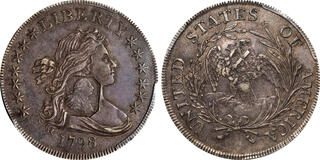| Stack's Bowers Galleries (& Ponterio) > January 2024 NYINC Auction | Auction date: 12 January 2024 |
| Lot number: 53273 Price realized: 100,000 USD (Approx. 91,190 EUR) Note: Prices do not include buyer's fees. | Show similar lots on CoinArchives Find similar lots in upcoming auctions on |
| Lot description: GREAT BRITAIN. Great Britain - United States of America. Dollar (5 Shillings), ND (1804). Geroge III. PCGS EF-40. S-3766B; KM-660.1; Bull-1873 (plate coin). Authorized 2 January 1804. Countermark: Bank of England Type II (the famous "head of a fool on the neck of an ass"); Bust of George III right utilized from the then current 6 Pence within octagonal indent. Applied to the obverse of a 1798 United States of America draped bust Dollar, small eagle reverse variety (B-1; BB-82). One of only 6 confirmed examples of the host country and the only certified example for both countermark types on either the NGC or PCGS population reports. This exceptional rarity exhibits beautiful cabinet patina with richer coloration amongst the devices. When rotated in the light a dusky iridescence becomes apparent adding to its visually pleasing appearance, while slightly subdued luster in the protected areas speaks through lending to its originality. This moderately worn example offers relatively smooth surfaces with even wear consistent for the grade. Truly an awesome example of the countermark type with an excellent provenance. It is important to note that most examples of the Bank of England countermarked issues are primarily found on Spanish colonial mint Dollars (8 Reales). Occasionally Spanish mints or other European countries can be found with few other host types known. By all accounts the present piece as a 1798 small eagle reverse Dollar appears to be UNIQUE, with all other examples traced with the octagonal countermark are the large eagle reverse of 1798 (British Museum) or 1799 (The Bank of England, Norweb, Lord Hamilton/Whetmore and Sinton Collections). Both the Bank of England and British Museum collections do contain examples of the oval countermarks also on a small eagle dollars, but the later is an electrotype of a 1795 that was acquired in 2004 by famous author and collector Harrington E Manville. Mr. Manville, one of the previous owners of the present example, was a highly respected and revered academic collector of countermarked dollars of England, Scotland and Ireland. His excellent book "Tokens of the Industrial Revolution" remains to be the standard reference on the subject of merchant countermarks, but only briefly touches on Bank of England issues. For a more detailed account of the operations surrounding the Bank of England countermarked coinage Mr. E.M. Kelly author of "Spanish Dollars and Silver Tokens" offers a reasonable explanation. According to Kelly, The Bank of England sent bags of 1,000 troy ounces of coins to the mint to be countermarked rather than specific Dollar amounts. Apparently, the bank was not particular about what the bags contained as long as the were the prescribed even weight of 1,000 ounces. Though the minors that carry these marks are considered by some to be spurious in nature, the most logical reason why so many exist today was to make up the weight deficiency. Unfortunately, the neither the mint or the bank kept records of each type or denomination that was countermarked. Ex: A-Tokyo Collection. Ex: Dr. Bruno Mantegazza Collection (Spink 3/1996) Lot # 87. Ex: Inveruglas Collection (Noble 7/1995) Lot # 4518. Ex: Hopetown House Collection (Spink 11/1988) Lot # 379. Ex: H.D. Gibbs Collection (Schulman 11/1960) Lot # 100. Purchased and sold privately by H. E. Manville between the Gibbs Collection and Hopetown collections. Plated in English Silver Coins by Maurice Bull pg. 267. Estimate: $100000 - $150000 |  |



